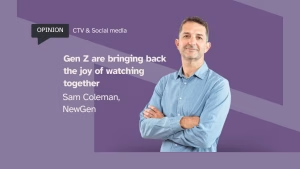New Digital Age has launched a three-part series of ‘Agency Talks’ in collaboration with Samba TV. In this first interview, we invite Tom Stimpfig, Head of Video at PHD, to discuss the data innovations shaping media planning amidst the rise of CTV in a cookieless landscape.
How would you characterise AV planning and buying in today’s modern media landscape?
The principle of reaching a mass audience at a cost-efficient price has not changed. For decades, this has been the most effective way to build brands. Traditionally, TV has been the most powerful tool to do this, but shifting viewership across multiple platforms means the days of using TV as a relatively blunt tool to reach most people are past us. TV has become a truly cross-platform, AV medium that is highly complex.
The availability of data and digital activation at scale means AV can be used to deliver campaigns throughout the marketing funnel; however, its role at the top remains unique. Maintaining AV’s ability to reach a mass audience at scale requires reaching a growing pool of Light Viewers. To deliver a cohesive brand experience across multiple touchpoints necessities data driven cross-screen and cross-channel planning in a way that can be measured and optimised, so that we can keep up with a growing pace of change in viewing consumption.
At PHD, not only are AV teams planners and buyers, but also specialists in data and measurement. This means we can provide clients with a holistic approach to AV and remove layers of complexity to activate highly effective campaigns.
What sort of data innovations are you incorporating into your planning process?
We integrate a range of data solutions into our planning process at PHD. An example of this includes audience insights from large viewing panels, such as Sky, into our tools and systems to allow for micro-spot optimisation so that every pound of investment is being stretched to deliver as much value as possible for the advertiser.
We are also working with Samba TV’s automatic content recognition (ACR) technology to bring their first-party viewership data into our AV planning. The privacy-first approach of their ACR makes it particularly appealing in the backdrop of cookie deprecation. It helps us secure a more holistic picture across linear and digital, which removes the data gaps.
Can you provide a use case where a new data-driven approach was effectively utilised for AV & CTV planning?
Since mid 2023 we have brought Samba TV’s ACR data into our planning process and made it widely available for most of our clients as a new strategy to drive incrementality.
Admiral, a top UK insurer, was one of the first adopters who leveraged Samba TV’s TV viewership data at a postcode sector level to identify household audiences who were under-exposed to Admiral’s linear TV campaign. This approach of understanding a brand’s linear TV ad exposure, using postcodes in the campaign as the identifier of audiences, was quite new and innovative.
We activated across the on-demand platform of one of our broadcaster partners using Samba TV’s insight into the bottom 20% of households least exposed to Admiral’s ad to optimise reach and frequency. By the end of the campaign, we brought 61% of those households out of the bottom quintile of ad exposure. Having a reliable grasp over under-exposure gives the planners much more control, and to be able to do that using offline-online data in digital environments is a strategic advantage that PHD has embraced in how we plan AV & CTV.
Lastly, how is cookie deprecation shaping agency planning and changing your approach to data?
A priority is helping clients mitigate the impact of an over-reliance on 3rd party cookies with the upcoming deprecation in Chrome. This is a journey we have been working on for a number of years through the development of privacy-safe, non-cookie reliant tools, as well as working with our partners to test new solutions in the landscape.
Our clients are increasingly working with clean rooms, which can be accessed via PHD’s end-to-end planning system ‘Omni’, to activate or suppress their first-party data in digital environments. We also work with partners who have large amounts of registered user data or large viewing panels that allow third or first-party data to be matched and activated online.
Another strategy we have taken at PHD is to leverage Samba TV’s ACR viewership data at the postcode level because it is entirely cookieless. The insights help to shape our cross-channel planning in a more seamless way across media touch points.
These are a couple of examples we have, but as the depreciation of cookies accelerates we are likely to see increasing opportunity and alternative tactics for activation of specific audiences without relying on cookies.










